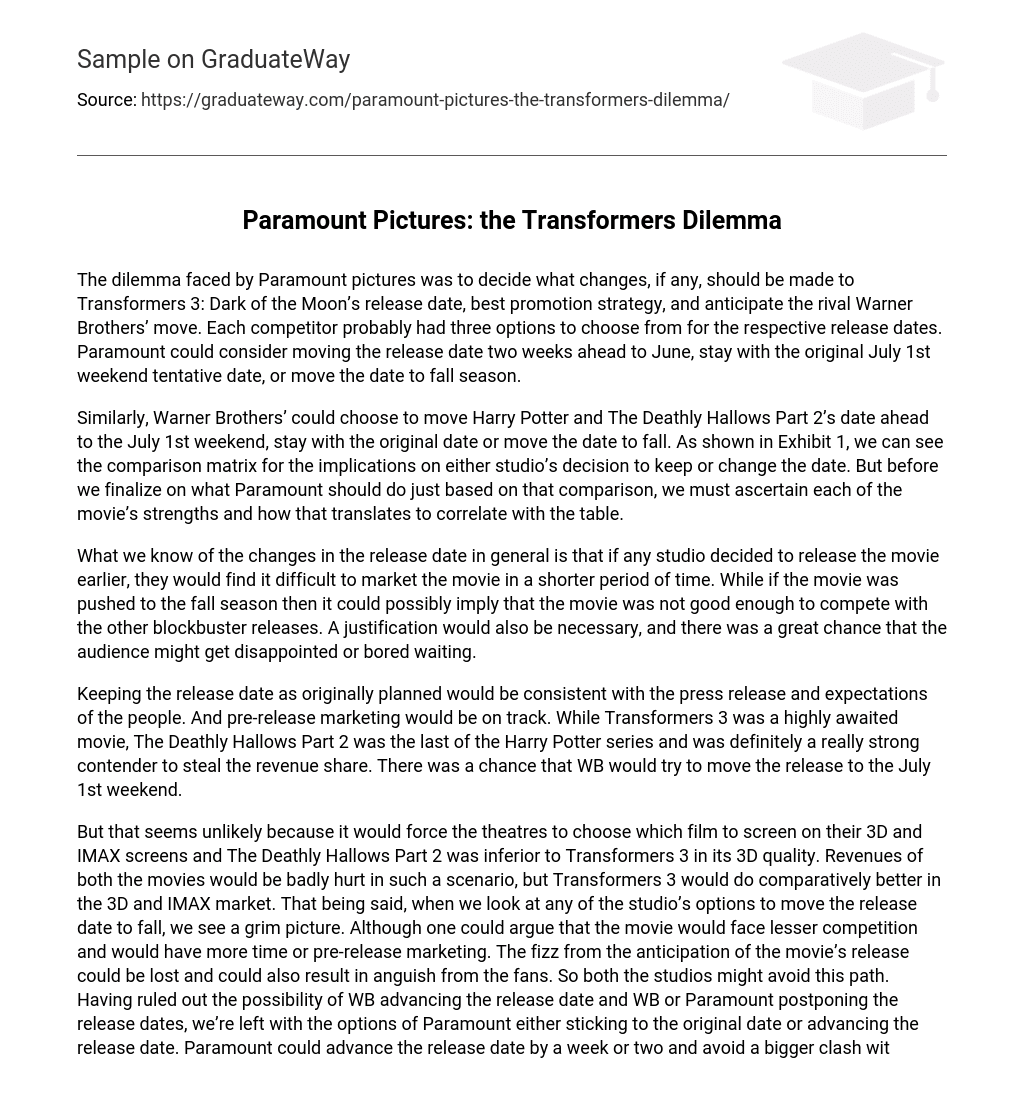Paramount Pictures was confronted with a dilemma regarding Transformers 3: Dark of the Moon. They had to choose whether or not to make changes to the film’s release date, promotion strategy, and also anticipate Warner Brothers’ possible actions. Both companies likely had three options for their respective release dates. Paramount could either move the date two weeks earlier to June, stick with the original July 1st weekend tentative date, or opt for a release in the fall season.
Similarly, Warner Brothers could determine whether to advance the date for Harry Potter and The Deathly Hallows Part 2 to the July 1st weekend, maintain the original date, or reschedule for the autumn. Referencing Exhibit 1, the comparison matrix outlines the consequences for both studios’ choices of keeping or altering the date. However, it is essential to analyze the strengths of each film and their alignment with the table before making a definitive decision for Paramount.
In general, changing the release date of a movie can present challenges for marketing. Releasing a movie earlier can make it difficult to effectively promote within a shorter timeframe. Alternatively, if a movie is delayed until the fall season, it may suggest that it was not deemed strong enough to compete with other blockbuster releases. Justifying the change in release date is crucial, as there’s a high likelihood of audience disappointment or boredom while waiting for the film.
Maintaining the original release date would align with the press release and public expectations, ensuring that pre-release marketing remains on schedule. Although Transformers 3 generated much anticipation, The Deathly Hallows Part 2 marked the final installment of the beloved Harry Potter series and posed a significant threat to revenue. There was a possibility that WB might consider rescheduling the release to the weekend of July 1st.
Theatre owners are unlikely to choose both Transformers 3 and The Deathly Hallows Part 2 for their 3D and IMAX screens due to the inferior 3D quality of the latter. If this were to happen, both movies would suffer financially, but Transformers 3 would fare relatively better in the 3D and IMAX market. However, moving the release date of The Deathly Hallows Part 2 to the fall could reduce competition and allow for more pre-release marketing time. Nevertheless, this might diminish anticipation among fans and result in disappointment. Hence, it is probable that both studios will avoid this option. With advancing or postponing release dates by WB or Paramount ruled out, the remaining choices are for Paramount to stick to its original date or advance it slightly to minimize conflict with WB.
The text suggests that increasing pre-release marketing efforts would allow for more time to generate revenue before sharing it with WB. However, there is a caveat: theaters typically take 10% of ticket sales in the first weekend and increase it by 10% each subsequent week. This means that a larger portion of earnings from the highly anticipated long weekend would go to theaters. Therefore, it may not be worth taking the risk of advancing the release date.
Due to the release of The Deathly Hallows Part 2, theaters would prioritize newer movies over one released a month ago. Paramount is now considering releasing Transformers 3 on its original July 1st weekend. This decision is supported by the past release patterns of the Harry Potter series, which were timed two weeks after the release of Transformers 1 and 2 in the summers of 2007 and 2009.
Paramount collected a greater domestic gross than WB on both occasions: $320M vs. $292M and $400M vs. $301M. Additionally, when considering the history of Harry Potter releases, it is evident that the franchise has not performed as well in the summer compared to fall releases. This gives Paramount some added confidence. Therefore, the best strategic decision for Paramount would be to maintain the original release date and focus on tailoring their pre-release marketing.
Paramount should focus on promoting the excellence of their 3D technology and educating customers to distinguish between high and low-quality 3D movies. It would be smart for Paramount to broadcast or screen the first two parts of the Transformers’ series shortly before or during the release week of Transformers 3. Although revenues will be shared with WB, we should aim to maximize earnings from initial releases and persuade theaters to allocate a significant portion of screening space to Paramount’s 3D and IMAX offerings.





